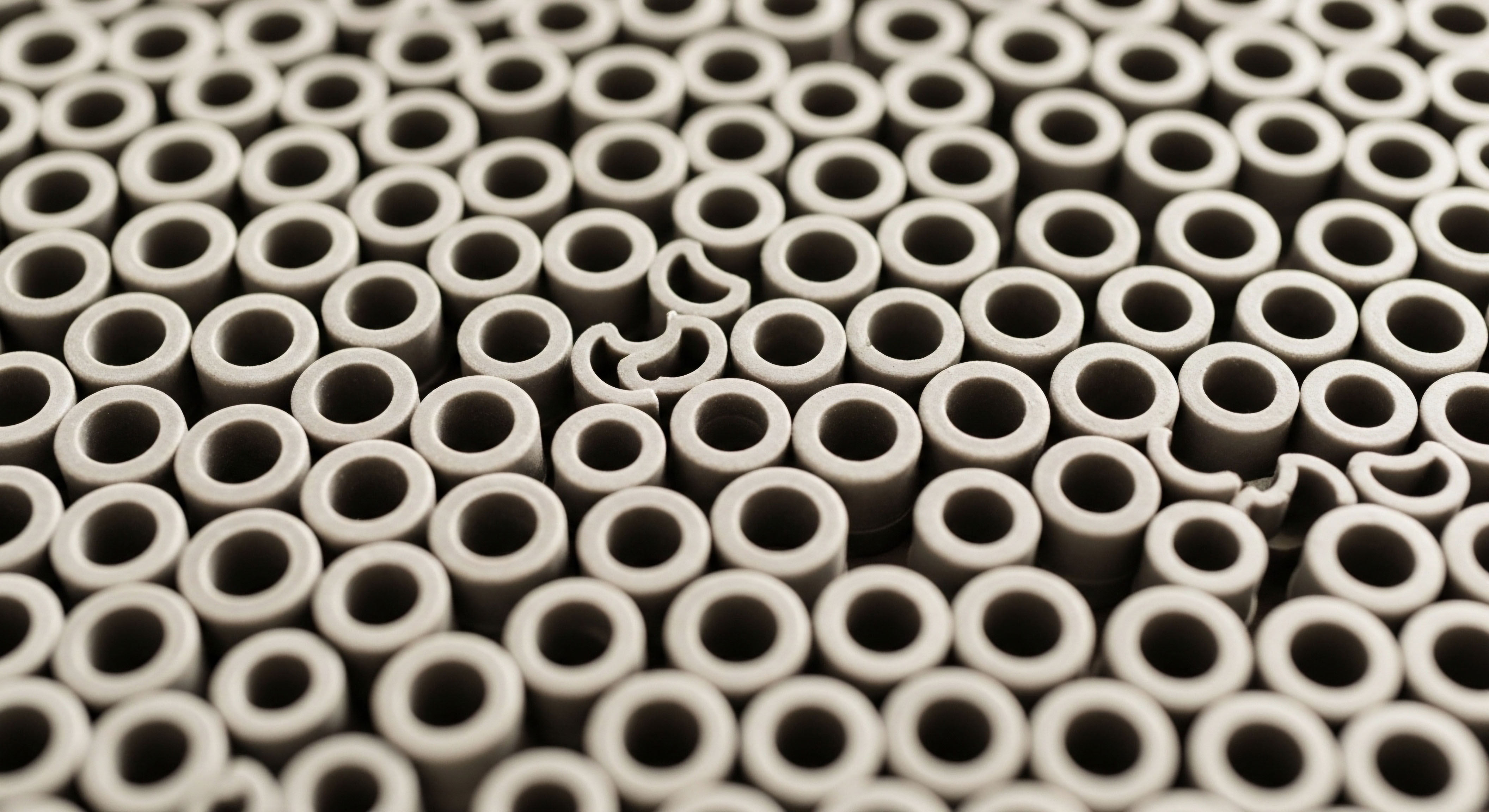

Fundamentals
The feeling of your internal systems being out of sync during a hormonal withdrawal period is a deeply personal and valid experience. You may feel a profound sense of fatigue, mental fog, or emotional volatility that seems to come from nowhere. This experience originates from a sophisticated biological control system recalibrating itself.
Your body is working to rediscover its own rhythm after a period of external support. Understanding this process is the first step toward actively participating in your own recovery and reclaiming your sense of vitality.
At the center of this experience is the Hypothalamic-Pituitary-Gonadal (HPG) axis. Think of it as your body’s internal messaging network, a precise feedback loop responsible for producing hormones like testosterone. The hypothalamus in your brain sends a signal (Gonadotropin-Releasing Hormone or GnRH) to your pituitary gland.
The pituitary, in turn, releases Luteinizing Hormone (LH) and Follicle-Stimulating Hormone (FSH) into the bloodstream. These hormones travel to the gonads (testes in men, ovaries in women), instructing them to produce testosterone and other essential hormones. When your body has enough testosterone, it sends a signal back to the brain to slow down production, maintaining a perfect equilibrium.

The Science of Withdrawal
When you introduce an external source of hormones, such as through Testosterone Replacement Therapy (TRT), your brain senses that levels are sufficient. In response, it quiets the HPG axis, turning down its own production signals. This is an intelligent, energy-saving adaptation.
The withdrawal period you experience is the time it takes for your brain to recognize the absence of that external source and begin sending its own signals again. The system must “reawaken” and re-establish its natural, pulsatile communication. This recalibration period can be challenging, as your body navigates a temporary state of low endogenous hormone production.
The duration and intensity of this recalibration vary from person to person. Factors include the length of time you were on hormonal support, the specific protocols used, and your underlying physiological state. The symptoms you feel are real and directly linked to this neuroendocrine transition. Your body is fully capable of restarting this system. Lifestyle interventions provide the essential resources and create the optimal environment for this process to happen efficiently and effectively.
Lifestyle interventions create the foundational biological environment necessary for your body’s hormonal systems to recalibrate and resume their natural function.
Supporting this reawakening process is where your daily choices become powerful tools. Your body doesn’t restart its hormonal engine in a vacuum. It requires specific raw materials from your diet, relies on the restorative processes of sleep, is influenced by the signals sent by exercise, and can be suppressed by the biochemical cascade of chronic stress.
These lifestyle factors are the inputs that directly fuel the HPG axis, helping it to reboot and find its equilibrium once more. You can become an active participant in your recovery, providing your body with the precise support it needs to restore its own inherent hormonal balance.


Intermediate
Lifestyle interventions can profoundly support hormonal balance during withdrawal by directly influencing the biochemical pathways that govern the Hypothalamic-Pituitary-Gonadal (HPG) axis. These are not passive actions; they are targeted biological inputs that provide the raw materials for hormone synthesis, regulate signaling molecules, and mitigate antagonistic processes that can hinder recovery. By strategically managing nutrition, exercise, sleep, and stress, you can create a physiological environment that encourages the HPG axis to come back online more robustly.

The Pillars of Endocrine Support
Each lifestyle pillar addresses a different component of the hormonal production and regulation system. They work synergistically to support the body’s return to endogenous testosterone production following the cessation of external hormone administration.

Nutritional Architecture for Hormone Synthesis
Your endocrine system requires specific nutrients to build hormones. A diet structured for hormonal recovery focuses on providing these building blocks while maintaining stable blood sugar, which is critical for proper signaling.
- Macronutrient Sufficiency Your body synthesizes testosterone from cholesterol, making healthy dietary fats essential. A diet very low in fat can impair hormone production. Adequate protein intake supports lean muscle mass and overall metabolic health, while complex carbohydrates help manage cortisol levels and provide sustained energy without causing sharp insulin spikes.
- Micronutrient Catalysts Certain vitamins and minerals are indispensable for the testosterone production cascade. Zinc acts as a crucial cofactor for enzymes involved in testosterone synthesis, and deficiency is directly linked to lower levels. Vitamin D, which functions as a steroid hormone, is also vital for healthy testosterone production. Magnesium plays a role in modulating the bioactivity of testosterone by influencing Sex Hormone-Binding Globulin (SHBG).
- Blood Sugar Regulation High blood sugar and the resulting insulin resistance can suppress HPG axis function. A diet rich in whole foods, fiber, and healthy fats, while minimizing processed sugars and refined carbohydrates, helps maintain insulin sensitivity. This ensures that hormonal signaling pathways remain clear and responsive.

Exercise as a Hormonal Stimulant
Physical activity, particularly resistance training, sends a powerful signal to the body that promotes anabolic processes, including testosterone production. The key is the type and intensity of the exercise.
Resistance training, such as weightlifting, has been shown to cause acute increases in testosterone levels. This type of exercise stimulates muscle tissue, which in turn signals the need for repair and growth, a process mediated by anabolic hormones. Conversely, excessive, prolonged endurance exercise without adequate recovery can elevate cortisol, a stress hormone that has a suppressive effect on the HPG axis. A balanced approach that prioritizes strength training and allows for proper rest is most effective for supporting hormonal recovery.
Strategic exercise, particularly resistance training, provides a direct anabolic signal that encourages the body to upregulate its own testosterone production.

The Role of Sleep in Hormonal Regulation
The majority of your daily testosterone release is tied to your sleep cycles. The pulsatile release of Luteinizing Hormone (LH) from the pituitary gland, which is the direct signal for the testes to produce testosterone, peaks during deep sleep. Chronic sleep deprivation disrupts this rhythm, leading to suppressed LH release and consequently lower testosterone levels.
Prioritizing 7-8 hours of high-quality, uninterrupted sleep per night is one of the most effective strategies for allowing the HPG axis to function optimally. This provides the dedicated window your body requires to perform its essential hormonal regulation and production activities.

Stress Management and the Cortisol Connection
Chronic stress is a powerful antagonist to hormonal balance. The body produces the stress hormone cortisol from the same precursor molecule (pregnenolone) used to create testosterone. Under conditions of chronic stress, the body prioritizes cortisol production, effectively “stealing” the raw materials that would otherwise be available for testosterone synthesis.
High cortisol levels also directly suppress GnRH release from the hypothalamus, further dampening the entire HPG axis. Practices like meditation, deep breathing, and mindfulness can help regulate the stress response, lower circulating cortisol, and remove this significant barrier to hormonal recovery.

Integrating Lifestyle with Clinical Protocols
For individuals discontinuing TRT, lifestyle interventions are the foundation for sustained recovery. In some cases, a clinician may recommend a “restart” protocol to actively stimulate the HPG axis. These protocols often use medications like Selective Estrogen Receptor Modulators (SERMs) such as Clomid or Tamoxifen, or gonadotropins like HCG.
These agents work by either blocking estrogen’s negative feedback on the pituitary or by directly stimulating the testes. Lifestyle interventions work in concert with these protocols. While medications can jump-start the system, a supportive lifestyle provides the ongoing fuel and favorable environment the body needs to maintain its own production long-term.
| Factor | Supportive Actions | Detrimental Actions |
|---|---|---|
| Nutrition |
Diet rich in healthy fats, quality protein, complex carbs, zinc, and vitamin D. |
Low-fat diets, high sugar intake, nutrient deficiencies, excessive alcohol consumption. |
| Exercise |
Consistent resistance training, high-intensity interval training (HIIT), and adequate recovery. |
Sedentary lifestyle, chronic overtraining, excessive endurance exercise without rest. |
| Sleep |
Consistent 7-8 hours of high-quality, uninterrupted sleep per night. |
Sleep deprivation, irregular sleep schedules, untreated sleep apnea. |
| Stress |
Mindfulness, meditation, adequate downtime, and stress-reduction practices. |
Chronic psychological stress, high cortisol levels, insufficient recovery from stressors. |


Academic
The successful restoration of endogenous hormonal balance following the cessation of exogenous androgen therapy is a complex neuroendocrine process. It relies on the functional integrity of the Hypothalamic-Pituitary-Gonadal (HPG) axis and can be substantially influenced by systemic factors modulated through lifestyle interventions.
From a systems-biology perspective, these interventions do not merely offer general wellness benefits; they actively regulate the signaling environment, substrate availability, and feedback sensitivity of the HPG axis, thereby facilitating its recovery from a state of induced suppression.

Neuroendocrine Mechanisms of HPG Axis Reactivation
Exogenous testosterone administration suppresses the HPG axis primarily through potent negative feedback at the level of both the hypothalamus and the pituitary gland. Elevated serum androgen and subsequent aromatization to estradiol inhibit the pulsatile secretion of Gonadotropin-Releasing Hormone (GnRH) from the hypothalamus.
This, in turn, downregulates the synthesis and release of Luteinizing Hormone (LH) and Follicle-Stimulating Hormone (FSH) from the anterior pituitary. The withdrawal of this exogenous source initiates a recovery period whose timeline is highly variable, ranging from months to, in some cases, years. Recovery is contingent on the restoration of GnRH pulse generation, pituitary responsiveness to GnRH, and gonadal sensitivity to LH and FSH.
Lifestyle interventions can directly modulate these recovery mechanisms:
- Metabolic Control and Leptin Signaling ∞ Body composition, particularly adiposity, plays a critical role. Adipose tissue is a primary site of aromatase activity, the enzyme that converts testosterone to estradiol. Excess adipose tissue can lead to higher estradiol levels, reinforcing the negative feedback loop and hindering HPG axis restart. Lifestyle interventions that promote fat loss, such as a hypocaloric diet and regular exercise, reduce aromatase activity. Furthermore, the adipokine leptin provides a permissive signal to the hypothalamus for GnRH release. Improved leptin sensitivity through better metabolic health can therefore support the reactivation of the central HPG axis pulse generator.
- GABAergic and Glutamatergic Tone ∞ The regulation of GnRH neurons is influenced by a balance of inhibitory (GABAergic) and excitatory (glutamatergic) neurotransmission. Chronic stress and elevated cortisol can enhance inhibitory GABAergic tone, suppressing GnRH release. Lifestyle practices that mitigate stress, such as adequate sleep and mindfulness, can help restore a more favorable excitatory balance, facilitating the resumption of GnRH pulsatility.
- Testicular Function and Leydig Cell Health ∞ The testes must regain their sensitivity to LH to produce testosterone. Chronic suppression can lead to a temporary reduction in Leydig cell function. Nutritional status is paramount here. Nutrients like zinc and antioxidants are vital for Leydig cell steroidogenesis and mitigating oxidative stress within the testicular microenvironment.

What Are the Most Effective Pharmacological Adjuncts?
In a clinical setting, HPG axis restart is often accelerated with specific pharmacological agents. These are not a replacement for lifestyle support but act as powerful catalysts. A post-TRT protocol may include:
- Selective Estrogen Receptor Modulators (SERMs) ∞ Agents like Clomiphene Citrate and Tamoxifen function as estrogen antagonists at the level of the hypothalamus and pituitary. By blocking the inhibitory feedback of estradiol, they effectively increase the secretion of LH and FSH, driving testicular testosterone production.
- Human Chorionic Gonadotropin (HCG) ∞ HCG is an LH analog that directly stimulates the LH receptors on Leydig cells in the testes. It is often used to maintain testicular size and function during TRT or to directly stimulate the testes to produce testosterone during a restart protocol before SERMs are introduced.
Pharmacological interventions can forcefully restart the HPG axis, but lifestyle factors determine the long-term sustainability of its independent function.
The interplay between these protocols and lifestyle is critical. A body with high inflammation, insulin resistance, and elevated cortisol will have a blunted response to these pharmacological stimuli and will struggle to maintain endogenous production once the agents are withdrawn. A healthy lifestyle creates a system that is primed to respond to restart protocols and capable of sustaining its own function afterward.

The Ancillary Role of Growth Hormone Peptides
While not a direct treatment for HPG axis recovery, Growth Hormone Peptide Therapies can play a valuable supportive role. Peptides such as Sermorelin (a GHRH analog) or combinations like CJC-1295 and Ipamorelin (a GHRH analog and a GH secretagogue, respectively) stimulate the body’s own production of Growth Hormone (GH). This has several downstream effects that are beneficial during a withdrawal period:
- Improved Body Composition ∞ Increased GH and subsequent IGF-1 levels can promote lean muscle mass and enhance lipolysis (fat loss). This directly addresses the issue of excess adiposity and aromatase activity.
- Enhanced Sleep Quality ∞ GH release is intrinsically linked with deep sleep. These peptides can help normalize and deepen sleep architecture, which in turn supports the nocturnal pulse of LH required for testosterone production.
- Metabolic Health ∞ Improved GH/IGF-1 status can contribute to better insulin sensitivity and overall metabolic function, creating a more favorable systemic environment for the HPG axis.
By improving these fundamental aspects of health, peptide therapies can indirectly support the body’s ability to recover its own hormonal production, acting as a complementary strategy to direct HPG axis stimulation and foundational lifestyle changes.
| Phase | Timeline | Primary Goal | Lifestyle Interventions | Potential Clinical Adjuncts | Key Lab Markers |
|---|---|---|---|---|---|
| Phase 1 ∞ Washout & Foundation |
Weeks 1-4 |
Clear exogenous hormones and establish foundational support. |
Strict adherence to sleep hygiene, stress management, nutrient-dense diet. |
None. Allow for natural clearance. |
LH, FSH, Total T, Free T, Estradiol (E2) |
| Phase 2 ∞ Active Stimulation |
Weeks 5-12 |
Stimulate pituitary and/or testicular function. |
Incorporate resistance training 3-4x/week. Optimize Vitamin D and Zinc intake. |
HCG followed by a SERM (e.g. Clomiphene or Tamoxifen) as per clinician. |
LH, FSH, Total T, Free T, E2, SHBG |
| Phase 3 ∞ Stabilization |
Months 4-6+ |
Taper off clinical adjuncts and maintain endogenous production. |
Maintain all lifestyle interventions consistently. Adjust diet/training as needed. |
Tapering schedule for SERMs as directed by physician. |
Monitor LH, FSH, and Testosterone levels to ensure stability. |

References
- Coward, Robert M. et al. “Recovery of spermatogenesis following testosterone replacement therapy or anabolic-androgenic steroid use.” Asian Journal of Andrology, vol. 18, no. 3, 2016, p. 373.
- Ramasamy, Ranjith, et al. “Testosterone Supplementation Versus Clomiphene Citrate for Hypogonadism ∞ A Randomized Controlled Trial.” The Journal of Urology, vol. 192, no. 3, 2014, pp. 875-879.
- Leproult, Rachel, and Eve Van Cauter. “Effect of 1 Week of Sleep Restriction on Testosterone Levels in Young Healthy Men.” JAMA, vol. 305, no. 21, 2011, pp. 2173-2174.
- Whirledge, S. & Cidlowski, J. A. “Glucocorticoids, stress, and fertility”. Minerva endocrinologica, vol. 35, no. 2, 2010, pp. 109-25.
- Pilz, S. et al. “Effect of vitamin D supplementation on testosterone levels in men.” Hormone and Metabolic Research, vol. 43, no. 3, 2011, pp. 223-225.
- Te, L. et al. “The effect of metformin on the hypothalamic-pituitary-testicular axis in men with late-onset hypogonadism.” Clinical Endocrinology, vol. 91, no. 3, 2019, pp. 446-453.
- Travison, Thomas G. et al. “The relationship between body composition and serum testosterone levels in middle-aged and older men.” The Journal of Clinical Endocrinology & Metabolism, vol. 92, no. 1, 2007, pp. 116-122.
- Sigalos, J. T. & Zito, P. M. “Sermorelin.” StatPearls Publishing, 2023.
- Khorram, O. et al. “Effects of a novel growth hormone-releasing peptide on growth hormone and cortisol secretion in man.” The Journal of Clinical Endocrinology & Metabolism, vol. 82, no. 5, 1997, pp. 1472-1479.
- Lykhonosov, M. P. et al. “Peculiarity of recovery of the hypothalamic-pituitary-gonadal (hpg) axis, in men after using androgenic anabolic steroids.” Problems of Endocrinology, vol. 66, no. 6, 2020, pp. 59-67.

Reflection
You have now explored the biological architecture of your hormonal system and the mechanisms by which it can be supported to find its own balance. This knowledge is a powerful asset. It transforms the often-disorienting experience of withdrawal into a clear, navigable process.
You now understand that the symptoms you feel are signals of a system in transition, a system that is actively working to restore its innate function. The path forward is one of conscious partnership with your own physiology.
This information serves as a map, outlining the terrain of your recovery. Yet, you are the one navigating this terrain. The principles of nutrition, exercise, sleep, and stress management are universal, but their application in your life is deeply personal. How does your body respond to certain foods?
What type of movement brings you a sense of strength and vitality? What practices genuinely quiet your mind? Answering these questions is part of the journey. This process of self-discovery, guided by clinical data and self-awareness, is the route to a sustainable, resilient state of well-being, built from the inside out.

Glossary

luteinizing hormone

hpg axis

lifestyle interventions

chronic stress

hormonal balance

endogenous testosterone

hormonal recovery

testosterone production

resistance training

testosterone levels

selective estrogen receptor modulators

leydig cell function

leydig cell

post-trt protocol

clomiphene citrate

hpg axis recovery




